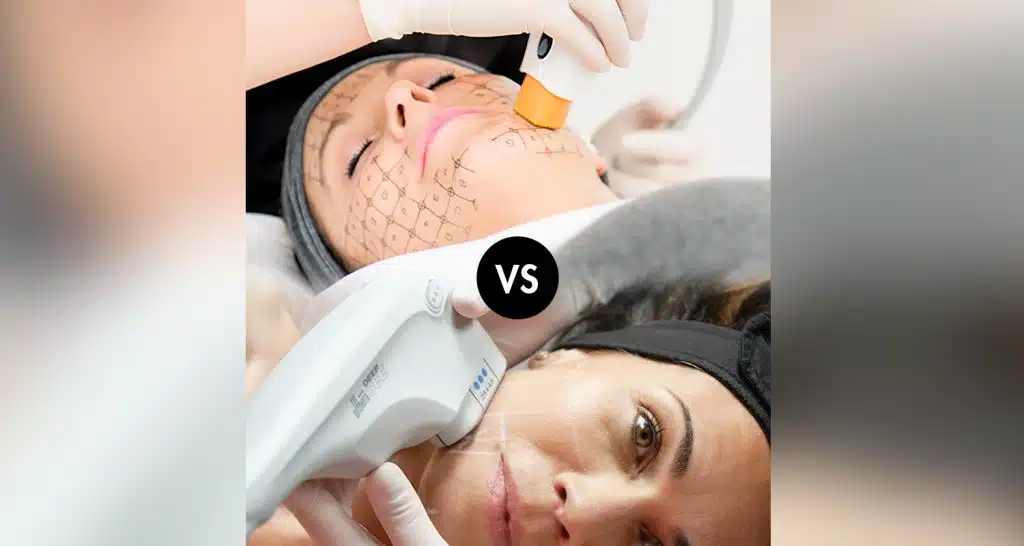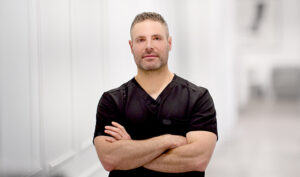Out of the various anti-aging procedures, Thermage and Ultherapy (Ulthera) have stood out for several years thanks to their proven effectiveness. While both technologies address sagging skin, they differ in the specific skin characteristics and needs they treat.
What is Thermage? What is Ultherapy? Which one is right for you? Find out now!
What is Thermage?
Thermage is a technology based on radio frequency that treats sagging skin by using heat. It targets collagen and elastin fibres, which form the mesh-like support tissue within the skin. When we are young, this mesh is tight and strong, giving the skin a firm and toned appearance. Over time, these fibres become loose, leading to a loss of firmness.
What is Ultherapy?
Ultherapy utilizes ultrasound technology to tighten sagging skin. Like Thermage, it works by heating deep layers of the skin to target the collagen and elastin fibres in the support tissue. This controlled application of heat stimulates a natural process that restores the skin’s firmness.
How does Thermage and Ultherapy work?
Thermage (radio frequency technology) and Ulthera (ultrasound technology) both rely on the use of heat to treat sagging skin. The skin is made up of collagen and elastin fibres that build deep within the skin and together form a mesh that supports various structures in the face. This mesh is called the support tissue. When we are young, the mesh is tight and strong and the skin looks firm and toned, but over time, the fibres become looser, and the skin loses its firmness.
Numerous scientific studies have shown that by inducting targeted and controlled heat into the skin, two phenomena impacting skin firmness occur. First, collagen and elastin fibres contract, providing an immediate toning effect on the skin. Then, in response to this unusual contraction, the body initiates a “repair” process, i.e., a renewal of the collagen and elastin fibres in the skin within a few weeks following the treatment. This deep action allows for a gradual firming of the skin, usually over a period of two to three months.
To illustrate the phenomenon of the contraction of elastin and collagen fibres, we can compare it to a wool sweater washed in hot water. Under the effect of the heat, the wool fibres will contract, and the sweater will be tighter when worn. And, as you wear it, the fibres will gradually loosen again. This is basically what happens in the skin when you apply specific heat to the collagen and elastin fibres in the skin and supporting tissue. Of course, these treatments do not stop the passage of time and, eventually, collagen and elastin levels will naturally decrease, and the signs of aging will appear again. This usually happens in about one to three years, after which time a new skin tightening procedure may be beneficial.

Thermage vs Ultherapy: What’s the Difference?
Both Thermage and Ultherapy use heat energy to stimulate collagen, but they target different skin layers. Thermage uses radiofrequency to tighten superficial layers, ideal for mild sagging. Ultherapy uses ultrasound to reach deeper layers, offering a stronger lift for pronounced sagging. Your choice depends on your needs and treatment goals.
1-Treatment objectives
Thermage
Knowing that we lose 1% of collagen per year from our thirties onwards, Thermage allows us to work proactively by preventing the natural degradation of collagen. This technology also corrects slight sagging in areas like the jowls, eyes, arms, abdomen, thighs and buttocks by tightening and smoothing the skin. It is the perfect technology to slow down the overall aging of the skin.
We love Thermage for its ability to:
› Prevent skin aging
› Smooth out superficial wrinkles
› Give a plumped-up effect to the skin
Ultherapy
Ultherapy has a deeper action that allows for tightening of the skin tissues and a defining effect on the contour of the face, the eyebrows, the neck and the décolleté in a single treatment.
We love Ulthera for its ability to:
› Redefine facial contours
› Firm the skin
› Give a lifting effect
2-Type of energy
While Thermage and Ultherapy both use heat to stimulate collagen production in the skin, they do so in different ways. Thermage works by combining unipolar radio frequency (RF) thermal energy with a cooling process that targets more superficial skin tissue from the dermis to part of the subcutaneous fat layer. Ultherapy works with ultrasound technology (HIFU or High Intensity Focalised Ultrasounds) that penetrate three subcutaneous levels: the deep dermis, the fat layer and the SMAS layer (located just above the muscles). This deep action results in a more pronounced and long-lasting tightening effect on the skin. In addition, the thermal energy of Ultherapy is concentrated in small points, allowing smaller areas to be treated with precision.

What is the SMAS layer?
The SMAS layer is a fibromuscular layer that lies 4.5 mm inside the skin and covers a large part of the face. It connects the facial muscles to the dermis and its purpose is to transmit, distribute and amplify the activity of all the facial muscles (this is why it is also described as the “facial muscle layer”). As we age, the SMAS layer becomes looser, causing the lower third of the face and jaw to sag, resulting in jowls and wrinkles (e.g., marionette lines) and accentuating the nasolabial folds. This is also the layer that is targeted in a surgical facelift.

3-Treatment areas
Another key difference between the two treatments is the areas they treat. With Thermage it is possible to treat the entire face, the eyes (including the upper eyelid) as well as several areas of the body such as the arms, the stomach, the thighs, and the buttocks, depending on the needs in terms of skin tightening or improvement of cellulite (from light to moderate). Ultherapy can only target the skin of the face, eyes (brow bone), neck and décolleté.

4-Treatment duration and recovery
A Thermage session generally lasts around 2.5 hours. Ultherapy, depending on the area to be treated, takes between 1.5 and 3.5 hours. Being non-invasive, neither treatment requires recovery time. Most people return to work immediately after their appointment.
5-Results*
Full results are usually seen after two to three months, when the process of elastin and collagen fibre renewal is complete. However, it is estimated that the quality of the skin continues to improve gradually for 6 months (and sometimes more) after a treatment.
6-Possible side effects
After a Thermage treatment, slight swelling and/or redness may be observed within 24 hours after treatment. These side effects are quite minor and disappear quickly. With regards to Ultherapy, bruising, redness and slight swelling may appear immediately during treatment or the day after the procedure. You may also experience inflammation and/or discomfort within 24-48 hours of treatment.
7-Frequency and maintenance care
One Thermage treatment per year is generally recommended to maintain results. Depending on skin condition and goals, a second session can be scheduled a minimum of six months after the first treatment. Ultherapy results tend to be more long-lasting, so repeat treatments are generally recommended every two to three years depending on skin condition. A Venus Freeze/Venus Legacy treatment at each change of season is also highly recommended to maintain results.
8-Profiles
The ideal candidate for Thermage typically has skin that looks and feels less firm or is loose (mild to moderate skin sagging). The typical Ultherapy candidate generally has skin that looks and feels less firm or is loose (especially under the chin and neck) and/or has fine lines and wrinkles in the décolletage area.
Thermage or Ulthera: which treatment to choose?
With its more superficial action and its ability to slow down the loss of collagen in the skin, Thermage is an ideal treatment to work on preventing skin aging and to treat superficial skin concerns such as very fine wrinkles or dilated pores. It will be a more appropriate treatment for you if you have mild sagging skin and your concerns are to improve the firmness, texture, and quality of your skin.
By targeting deeper subcutaneous layers, the lifting effect is generally more pronounced, and results are more durable with Ulthera (especially when correcting concerns such as sagging jowls or eyebrows). If you have moderate skin sagging, especially under the neck or chin, and are looking for skin tightening and tightening, Ulthera is probably a better choice.
In order to make an informed choice between these two treatments, we recommend that you request a consultation with one of our experts. Thanks to their specialized training, they will be able to assess your skin and recommend the approach best suited to your needs.
* Treatment results may vary from person to person depending on the individual’s ability to produce new collagen.






